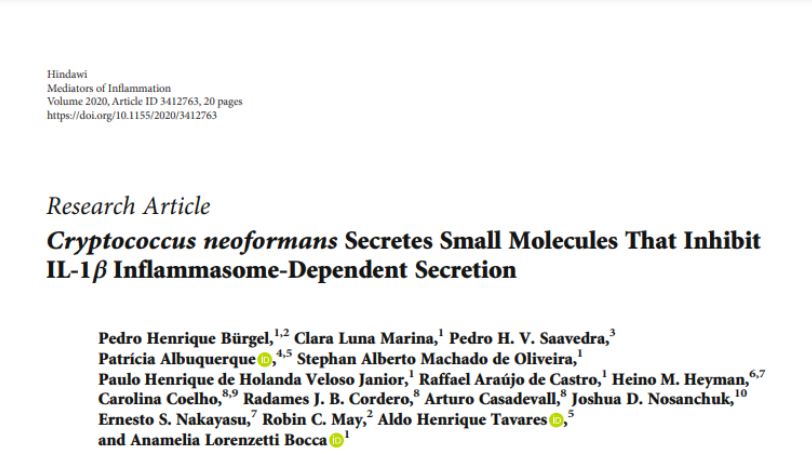Publicações Principais
Cryptococcus neoformans Secretes Small Molecules That Inhibit IL-1β Inflammasome-Dependent Secretion
Abstract
Cryptococcus neoformans is an encapsulated yeast that causes disease mainly in immunosuppressed hosts. It is considered a facultative intracellular pathogen because of its capacity to survive and replicate inside phagocytes, especially macrophages. This ability is heavily dependent on various virulence factors, particularly the glucuronoxylomannan (GXM) component of the polysaccharide capsule. Inflammasome activation in phagocytes is usually protective against fungal infections, including cryptococcosis. Nevertheless, recognition of C. neoformans by inflammasome receptors requires specific changes in morphology or the opsonization of the yeast, impairing proper inflammasome function. In this context, we analyzed the impact of molecules secreted by C. neoformans B3501 strain and its acapsular mutant Δcap67 in inflammasome activation in an in vitro model. Our results showed that conditioned media derived from B3501 was capable of inhibiting inflammasome-dependent events (i.e., IL1β secretion and LDH release via pyroptosis) more strongly than conditioned media from Δcap67, regardless of GXM presence. We also demonstrated that macrophages treated with conditioned media were less responsive against infection with the virulent strain H99, exhibiting lower rates of phagocytosis, increased fungal burdens, and enhanced vomocytosis. Moreover, we showed that the aromatic metabolite DL-Indole-3-lactic acid (ILA) and DL-p-Hydroxyphenyllactic acid (HPLA) were present in B3501’s conditioned media and that ILA alone or with HPLA is involved in the regulation of inflammasome activation by C. neoformans. These results were confirmed by in vivo experiments, where exposure to conditioned media led to higher fungal burdens in Acanthamoeba castellanii culture as well as in higher fungal loads in the lungs of infected mice. Overall, the results presented show that conditioned media from a wild-type strain can inhibit a vital recognition pathway and subsequent Hindawi Mediators of Inflammation Volume 2020, Article ID 3412763, 20 pages https://doi.org/10.1155/2020/3412763 fungicidal functions of macrophages, contributing to fungal survival in vitro and in vivo and suggesting that secretion of aromatic metabolites, such as ILA, during cryptococcal infections fundamentally impacts pathogenesis.


